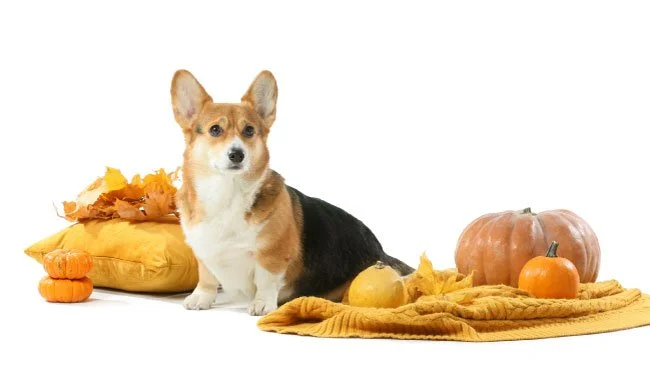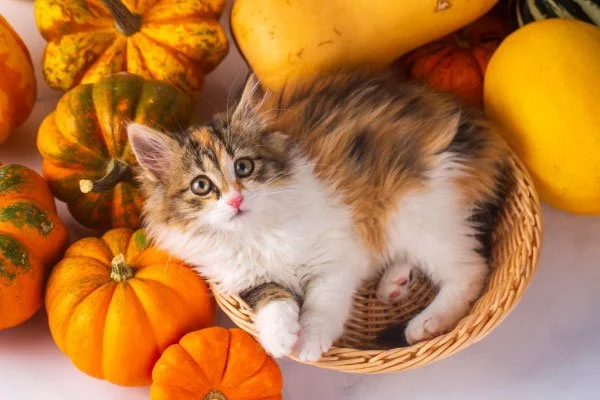Pumpkin: A Pet’s Fall Favorite
While you're sipping your latte or baking pies, don’t forget your furry friend can enjoy pumpkin too! Both cats and dogs can safely enjoy this festive favorite, and it’s more than just a tasty treat!
Whether your pet is dealing with a bit of constipation or the opposite problem, pumpkin can be a gentle, natural way to help. Thanks to its high fiber content, just a spoonful of plain canned pumpkin can help regulate digestion and keep your cat or dog’s tummy feeling good. It’s a simple, tasty fix for those occasional digestive hiccups and most pets love the flavor too!
Pumpkin is low in calories, but high in fiber, which means it helps your dog or cat feel full without the extra calories. It’s a great way to add a little bulk to their meals and keep them satisfied longer if you’re trying to get your pet to shed a few extra pounds.
Packed with vitamin A, zinc, and healthy fatty acids, pumpkin can help improve your pet’s skin and coat. Whether your dog’s dealing with dry skin or your cat needs a little extra shine, adding a bit of pumpkin to their meals can help them look and feel their best. It’s like a spa day, but in a bowl.
Pumpkin has a high water content, which can help keep your pet hydrated—especially if they’re not big water drinkers. Adding a spoonful to their food is an easy way to support hydration while also giving them a tasty, nutrient-rich treat.
Who knew something as humble as pumpkin could be such a powerhouse for your pet? Whether it’s helping with digestion, adding a little shine to their coat, or just being a tasty treat, pumpkin’s got a lot going for it.
Just remember—plain, unsweetened pumpkin only, and always check with your vet before making it a regular thing. A spoonful here and there could make a big difference (and earn you some serious tail wags or purrs).
Reference:
What Fruits and Vegetables Can Dogs Consume? Which Should They Avoid?
While some fruits and veggies can be a great addition to your dog’s diet, others can cause anything from an upset tummy to serious health issues. Knowing the difference isn’t just helpful, it’s essential to ensure your pup lives a long and healthy life!
️✔️ Safe Fruits for dogs (in moderation):
Blueberries: packed with antioxidants and fiber, all while low in calories.
Strawberries: high in vitamins A & C, helps with teeth whitening.
Watermelon is hydrating and vitamin-rich; remove all seeds and the rind.
Cantaloupe: full of beta carotene and water, offered in small seedless chunks.
Mango: loaded with vitamins A, B6, C, and E. Always remove the pit, as it contains cyanide.
❌ Unsafe Fruits for Dogs:
Grapes: extremely toxic, can cause kidney failure.
Avocado: contains persin, which could cause GI issues and heart problems.
Lemons: too acidic and may cause central nervous system depression, as well as GI issues.
Cherries: pits and stems contain cyanide, while the whole cherry is a choking hazard.
Figs: can cause extreme diarrhea and upset stomach.
✔️ Safe Vegetables for Dogs:
Kale, in moderation, supports immune health and contains calcium.
Green Beans: great for fiber and vitamins.
Cucumbers: hydrating and crunchy.
Sweet Potatoes: must be fully cooked, packed with fiber and vitamin A.
Pumpkin: excellent for digestion and an upset tummy.
❌ Unsafe Vegetables for Dogs:
Onions: can destroy red blood cells and lead to anemia.
Garlic: can cause toxicity over time.
Tomatoes: While ripe tomatoes themselves are safe, unripe tomatoes and their stems contain solanine.
Rhubarb: can cause kidney failure and drop calcium levels.
Wild Mushrooms: many may be toxic and therefore deadly.
References:
What fruits and vegetables can dogs eat? - Blue Cross
Fruits and Vegetables Dogs Can or Can’t Eat – American Kennel Club
Pup Eating Watermelon Photo: iStock Credit Anna Belova and Canva Premium
Pup with Carrot — Purina US photo
Tips to Keep Your Cat from Scratching Your Furniture
You're not alone if your cat’s scratching is ruining your furniture! In this post, we’ll explore simple and practical solutions to protect your home while keeping your feline friend happy.
Keep the Environment Stimulating
Cats scratch to release energy. Interactive toys, perches, climbing spots, and hiding places will mentally and physically stimulate your cat and reduce the likelihood of scratching furniture out of boredom.
Trim Your Cat’s Claws Regularly
While this does not eliminate the behavior, regularly trimming your cat’s claws reduces the damage they may cause.
Cover Furniture with Protective Materials
Use protective furniture covers on common scratching spots, such as the corners of sofas, to reduce the wear and tear on your furniture. Cats dislike sticky surfaces, so double-sided tape may be applied as a furniture asset to keep them away.
Offer Scratching Materials
Redirect your cat to scratching materials such as scratching posts or a cat tree to avoid scratching on furniture.
Feliway Diffusers
Feliway is a product that mimics feline pheromones and can calm your cat. A calm environment and a Feliway scent plug nearby may reduce your cat's urge to scratch furniture by helping it feel more comfortable.
Refer to our post about Cat Scratchers and When to Replace Them, to find out more about the timeline of some scratchers!







